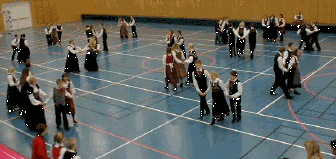
G B G
G
G
B
B
G
G
G B G
Dear friends in Portugal, Galiza, Greece, Scotland and Finland
Thank you for your nice letters - the last letter from Greece made us believe that there are other things than rainy November in the world! In Norway we’ve had rain for a month and a half, with storms and floods and temperatures far above what’s ordinary for this time of the year.
Our dance is now videotaped and will be sent you as soon as it is copied. We find that it turned out rather nicely, in spite of the youngsters’ rather dubious attitude to folk dance in general. BUT they are quite proud by the result and looking forward to learn your dances!
As you will see on the video, all the girls are wearing Norwegian national costumes. Those who didn’t have one themselves, borrowed from aunts, sisters and neighbours - and people in the neighbourhood who thought the project so interesting that they gladly contributed. As for the boys, we had more problems getting them a matching outfit. Few men in Norway have a national costume, and our boys are too small to fit them. Therefore they are wearing trousers, vests, white shirt and a checked bow ties; an outfit which was quite common in the days when our women naturally wore national costumes (up to 1880ies in the countryside). We call a national costume BUNAD, and our pupils will tell you more about it in a letter.
And now to the
DANCE
The dance comes from the Western part of Norway and is called "Three-tour from Fana" (TRETUR FRA FANA in Norwegian) or "Twelvecross-dance" (TOLVKROSSDANS in Norwegian). The reason for the names is that 3 persons dance together in a team (three-tour), and 4 teams dance in a square formation towards the middle and back, thus making a cross of twelve persons (twelvecross).
This is the starting point - one boy in the middle and a girl on each side of him:
|
|
G B G G
G G B G |
The boy in the middle puts his left hand into the left hand of the girl on his left, and his right hand into the right hand of the girl on his right.The two girls join hands behind the boy’s back. It is vital that the dancers’ hands stay together all through the dance!
When the music starts, the dancers keep their hands in shoulderheight and the boy makes an appeal - up on his toes and a short stamp when he falls back again (not very visible on the video), marking the rythm to come slightly with his hands.
They now all start dancing towards the middle of the "cross" and back with walking-steps. They start with their left foot and count 4 steps forward and 4 steps backward. This is repeated, according to the rythm and the music, 4 times (32 steps).
| And now comes the tricky part - the socalled turning-tour ("SMETTETTUR" in Norwegian). The girls form a "gate" with their hands. The boy bows slightly and sneak backward through the gate, taking his left girl with him first, and then his right girl. He now dances slightly forward to the left and half around his left girl, while he is leading his right arm over the heads of the girls. Lastly the boy turns around under his own right arm and they all come back to their original positions. It’s important that the girls just follow the boy in his movements. Every turning tour makes out 8 steps. |
|
The dance is an old "flirtation dance", and the boy is supposed to smile and flirt with the girls, and they shall try to win his attention. This doesn’t quite work with our pupils nowadays, and the number of boys and girls doesn’t match 1:2, so three of the same sex have to dance together. Also, we think the dance will improve by more practise, but we had to make the videotaping now, because of Christmas exams coming up by the end of the month.
This is a rather lengthy letter, but then I haven’t written before, so I hope you forgive me.
Good luck with the dance!
Inger Thinn (the "colleague"!).